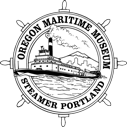ENGINE ROOM
The stern wheel is driven by one engine through two 900 horsepower cylinders. The port (left) cylinder is shown with the upper silver pipe delivering the steam to both ends. Valves at each end inject the steam so the piston is driven in both directions (double-acting). The pistons are 26 inches in diameter with a stroke of 108 inches. The two cylinders together produce 1800 horsepower. The energy from the piston is transmitted through the connecting rod out the back of the cylinder to the pitman arm that reaches through the aft bulkhead to the crank at the stern wheel. The long rods inboard of the pitman arm operate the valves at each end of the cylinder controlling the timing and direction of each stroke. The steam is used once and is exhausted into the big white colored pipe below the input. It then is taken back to a set of heat exchangers that use it to pre-heat the fresh feed water going into the boiler.
Small glass containers filled with oil are secured to the top of several joints on the cylinder arm. The containers open when the lever on their top is vertical, and lubricate the joints by gravity and capillary action.
Inboard of the cylinders are two green feed water pumps that deliver the water to the boiler. This was originally river water but is now taken from two 10,000-gallon onboard tanks filled with city water to help keep the system clean.
Behind the port feed water pump is a small black one that was used for potable water. Behind the starboard pump is the red pump that feeds the fire suppression system. All these units are steam driven.
The white canister in the center of the deck is an old steam driven DC generator. This has been replaced by a diesel generator, which supplies all the electrical power to the vessel. All of the DC wiring onboard has been replaced by marine quality wire for the AC power.
Mounted on the ceiling is the long black throttle lever that operates the valve delivering steam to the cylinders. Pushing it forward increases speed and back decreases it. The engineer's telegraph can be seen to the starboard of the throttle. The bell and gong are mounted above.
On the port (left) side aft (rear) of the potable water pump is a long black lever. It is the manual shifter for controlling the rotational direction of the wheel and thus the forward or reverse direction of the vessel. A small brass lever on top of a valve is the steam-assisted shifter. In the forward position these levers drive the vessel forward and back will reverse it.
On the starboard side of the area is another long black lever. This one operates an economizer system that acts much like overdrive in a car. The engineers VHF radio can be seen mounted on the pole aft of the throttle.
